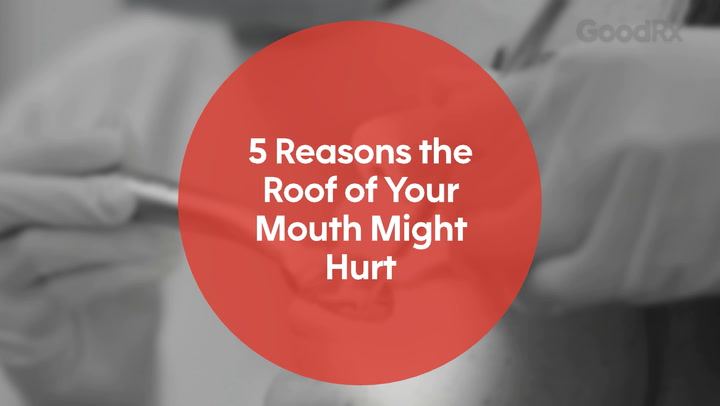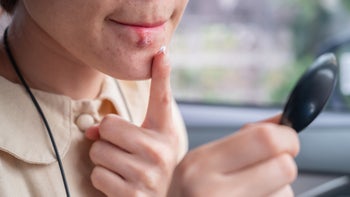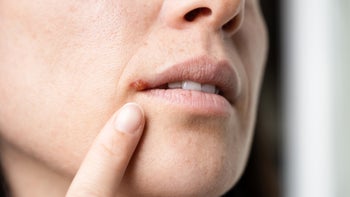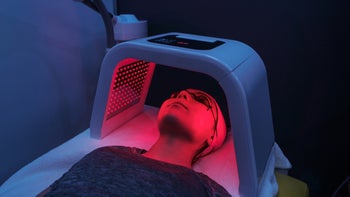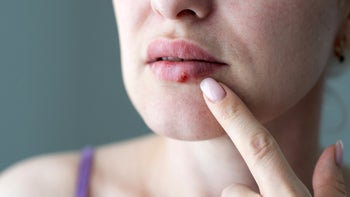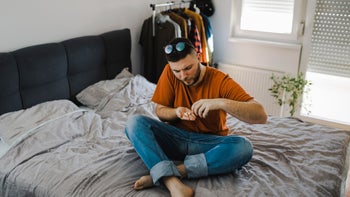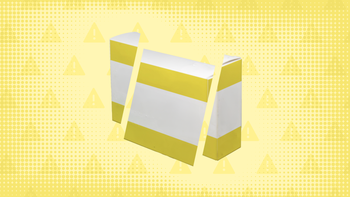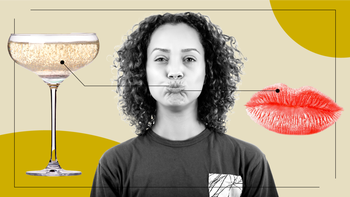
What Are Cold Sores, and How Can You Get Rid of Them? Causes, Treatments, and Pictures
Key takeaways:
Cold sores are caused by the herpes simplex virus (HSV). HSV is spread through contact with infected saliva or skin.
After the initial infection, HSV tends to stay inside the body in a dormant state. But the virus can be activated from time to time, leading to breakout infections.
Breakouts can be treated with antiviral medications, but they’ll also resolve on their own after the breakout has run its course.
Access savings on related medications
If you’ve ever had a tingle or itch on your lip that formed a cold sore blister, you’re not alone. Cold sores are common, and they affect more than half of all people worldwide.
You may be wondering where cold sores come from and how to get rid of them fast. So, let’s take a closer look at what causes cold sores, along with pictures of what they look like and the best treatments to help them go away quickly.
What are cold sores?
Cold sores are small blisters caused by the herpes simplex virus (HSV). They can also be called fever blisters or oral herpes.
There are two types of HSV: HSV-1 and HSV-2.
HSV-1 is the type that tends to cause sores in and around the mouth. It can lead to sores located:
On or around your lips
Inside your mouth
Inside your nostrils
On your cornea (the clear surface layer of your eye), although this is more rare
A guide to cold sore medications: Learn about the most effective over-the-counter and prescription medications for cold sores.
What does a cold sore feel like? Three women share their experiences with cold sores and how they overcame symptoms.
Are cold sores contagious? Yes. Here’s what you need to know about how long cold sores are contagious and how they’re spread.
On the other hand, HSV-2 tends to cause genital sores (also known as genital herpes). But this isn’t a fixed rule. Both HSV types can cause herpes sores in or around your mouth and your facial, genital, or groin areas.
What do cold sores look like?
After they appear, cold sores usually go through different stages before healing. Here are the different stages of cold sores with pictures.
Cold sores stages with pictures
Blisters
The site where a cold sore will appear often feels swollen. Or it may tingle, burn, or itch. Within a day or two, you may see small but painful, fluid-filled blisters on your lips, under your nose, or on other parts of your face. These tend to erupt in clusters.

Open blisters
During the next stage, clusters near each other merge and the blisters burst open. These leave painful, open sores that can ooze fluid.

Crusting
After a few days, scabs or crusts form over the open sores as they start to dry out. These will likely fall off and heal within a week or two after the cold sores first surfaced. You’re less likely to infect others once this cold sore crust forms.

What are the symptoms of a cold sore?
Not everyone develops cold sores or symptoms from HSV entering their body. But when the sores and symptoms do occur, the primary or first infection tends to be the worst.
During this initial infection, cold sores may be accompanied by signs and symptoms that mimic the flu, such as:
Fever
Headache
Body aches
Sore throat
You may also notice that your lymph nodes become swollen. These are small, circular organs that are important for your immune system. They contain immune cells that attack and kill viruses and other foreign invaders. Lymph nodes are found in areas such as:
Neck
Under your chin
Armpits
Groin
If the cold sores come back, they tend to be at or near their previous spot. Other symptoms tend to be milder after the initial outbreak.
How do you get rid of cold sores?
Oral herpes medications prescribed by a healthcare professional can shorten how long sores last. They work best when you take them within 72 hours of an outbreak. They may also be prescribed to prevent cold sores that come back often. Examples of these medications include:
Valacyclovir (Valtrex)
Acyclovir (Zovirax)
Famciclovir (Famvir)
Your sores will heal by about a day faster if you take antiviral creams, ointments, patches, and gels. These usually contain the medications acyclovir or penciclovir, and you can buy them over the counter (OTC). Another OTC option is Abreva (docosanol).
These OTC medications work best when you start them within 24 hours of your first cold sore symptom.
Home remedies and self-care for cold sores
Fortunately, there are also some home remedies that can help relieve cold sore symptoms and may reduce swelling. You can try:
A cold compress on the cold sore for pain and swelling
OTC pain medication, like ibuprofen and acetaminophen
Benzocaine or lidocaine gel (like Orajel or Anbesol) to help numb pain
Lysine supplements (talk to a healthcare professional before starting new supplements)
Propolis cream (a substance made by bees)
Are cold sores contagious?
Yes. HSV is spread through direct physical contact with someone who has the virus. This can happen through kissing, oral sex, or sharing items such as drinkware or bath towels.
The virus is most often transmitted when sores are visible. But you can also spread it when no cold sores or symptoms are present.
What are cold sore outbreaks?
Once infected, the HSV virus tends to live inside someone’s body for their whole life. It can lie dormant for years and never cause symptoms. Or it can cause periodic cold sore outbreaks.
How often these outbreaks occur can vary from person to person. Some people may not have an outbreak for years. Others may get cold sores at least once a month. These outbreaks tend to occur less often after age 35.
What causes cold sores?
It isn’t always clear what causes cold sore outbreaks. But they tend to occur during times when you have a weakened immune system. This is because your immune system tends to keep the virus in check most of the time.
Cold sores may occur when your immune system is busy fighting off another illness, such as the common cold or the flu. Health conditions that cause more long-term changes to your immune system, like HIV, can also trigger cold sores. This is also true for treatments that suppress your immune system, such as medications for people who have had organ transplants.
Cold sore triggers
Other triggers may include:
Physical or emotional stress
Fatigue
Extreme hot or cold temperatures
Ultraviolet (UV) rays
Hormone changes, such as those that occur during the menstrual cycle or pregnancy
Trauma to the mouth, such as that caused by dental work or sunburned or cracked lips
How to keep from spreading the virus
Here are some actions you can take to curb the spread of HSV:
Don’t touch cold sores.
Don’t share items that may come into contact with a cold sore, such as drinkware and hygiene and cosmetic products.
Wash your hands well and often, especially if you touch a sore and before and after treating one.
Avoid oral or genital contact any time someone has a herpes outbreak in either location.
Apply sunscreen on your face and lips before you go out into the sun.
Avoid contact sports if you or someone you play with has a cold sore.
And try to find healthy ways to cope with stress, especially if it’s one of your triggers. This may involve stress management techniques such as daily meditation. Or it may involve taking a mindful walk that allows you to calm your mind as you focus on each breath and step you take.
When to see a healthcare professional
Although cold sores and their symptoms often get better on their own, it’s best to see a healthcare professional if you have:
Sores that don’t get better within a few weeks
Severe cold sore pain, even after treatment with OTC medicine
A high fever or one that won’t go away
Multiple swollen lymph nodes (that are painful or swollen for more than a few days)
Bleeding or oozing from your sores that doesn’t stop
It’s also a medical emergency if the sores spread to your eyes. This is because they can lead to scarring that permanently affects your vision. So you should see a healthcare professional right away in the following cases:
Your eyes feel painful, sensitive to light, or blurry.
Your eyes tear or have mucus discharge.
Your eyes swell or turn red.
You have swollen eyelids.
You have painful blisters on your upper eyelid and one side of your forehead.
Frequently asked questions
The fastest way to get rid of a cold sore is to start using medication (like acyclovir pills or Abreva cream) as soon as you experience the first symptoms. Doing this can make cold sores go away about a day faster than they would on their own.
Most cold sores heal on their own within a week or two without treatment. Cold sore treatments can speed up healing and relieve pain.
Avoid treating your cold sores with harsh substances that could irritate it further, like rubbing alcohol, harsh soaps, or exfoliating scrubs. It’s also important not to touch your cold sore (other than applying medication) or to pick at it. You may also want to avoid salty or acidic foods, which may sting if they come into contact with the cold sore.
The bottom line
Cold sores are another name for oral herpes caused by HSV. They often crop up on your lips. But they can also break out in your mouth, on your nose, or in or around your eyes. They’re highly contagious, and you can easily spread them, even if you don’t have symptoms. There’s no cure for HSV infection. But you can manage cold sores and their symptoms with antiviral medications and by avoiding your triggers.
Why trust our experts?



Images used with permission from VisualDx (www.visualdx.com).
References
Ahmad, B., et al. (2024). Herpes simplex keratitis.
American Academy of Dermatology Association. (n.d.). Cold sores: Who gets and causes.
Crimi, S., et al. (2019). Herpes virus, oral clinical signs and QoL: Systematic review of recent data. Viruses.
InformedHealth.org. (2022). Cold sores: Learn More – how effective are creams and tablets for the treatment of cold sores? Institute for Quality and Efficiency in Health Care.
InformedHealth.org. (2022). Overview: Cold sores. Institute for Quality and Efficiency in Health Care.
Know Your Teeth. (2012). What are cold sores?
Kriesel, J. D., et al. (2014). Cold sore susceptibility gene-1 genotypes affect the expression of herpes labialis in unrelated human subjects. Human genome variation.
MedlinePlus. (2023). Propolis.
Mount Sinai. (n.d.). Herpes simplex virus.
Mount Sinai. (n.d.). Lemon balm.
National Health Service. (2024). Cold sores.
World Health Organization. (2024). Herpes simplex virus.
Zhu, S., et al. (2021). Pathogenesis and virulence of herpes simplex virus. Virulence.


